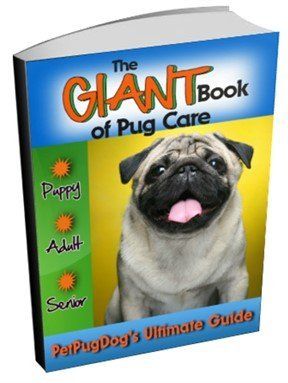Life Span

Pug Life Span
How Long Pugs Live
The life expectancy of a Pug dog is between 12 and 15 years, though the majority of Pugs succumb closer to the low end of this. The average male will live 12.8 years and female Pugs live a bit longer, with average life span being 13.2 years. This said, a Pug can live well into his teens (15, 16 or even 17 years).
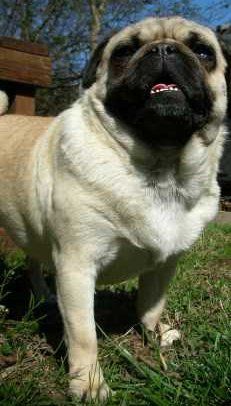
Top Causes of Death for Pug Dogs
A 20 yearlong study has recently concluded that looked into the top causes of death for purebred and mixed dogs. Medical records of 74,556 dogs were studied and those results were recently published.
In this 2 decade long study, there were over 100 Pug dogs involved.
Puppies were categorized separately, since they did not pass due to illness that affects senior Pugs that reached typical life expectancy.
For puppies (1 year old and under) the 2 most common reasons are:
trauma and infection. This is followed by congenital disease.
The 4 top causes of death for adult Pugs are:
1) Neurological disorders –
This is the #1 cause of death for the Pug breed (27.4%) . This refers to any disorder affecting the dog’s nervous system. The nervous system includes the brain, spinal cord and nerves.
The most frequently seen and fatal neurological disorder seen with the Pug breed is Pug Dog Encephalitis. This Pug disease
causes an inflammation of the brain which in turn causes seizures, lethargy and loss of muscle control.
There is much more to learn about this often fatal disease; however research is slow due to the fact that it is breed specific and only affects Pugs.
2) Cancer –
This is the #2 cause of death for the Pug breed (12.5%) . The forms of cancer that most often strike with this breed are: skin tumors, mammary tumors (spaying a female greatly reduces the odds of this developing), testicular tumors (neutering a male eliminates the odds of this developing), mouth cancer and lymphoma.
Skin cancer is the top leading cancer with Pug dogs, 1/3 of all tumors found with the breed are skin tumors. Out of that number, 20% are mast cell tumors. Mast cells are cells that are normally found throughout the body and work to help a dog respond to inflammation and allergies.
With fatal mast cell cancer the most common areas on the body to find tumors are: main body (45%) , hind legs (40%), head or neck (10%). Ten percent are found in other areas and for Pugs diagnosed with this, 11% have tumors in more than one area of the body.
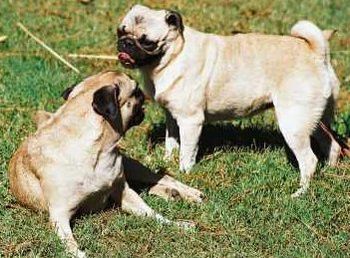
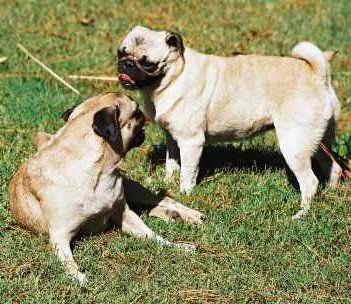
3) Infection –
This is the 3rd leading cause of death of adult Pug dogs (10.9%). This includes a range of diseases including: Viral disease, (parvovirus, distemper), bacterial infection (leptospirosis and most tick diseases), fungal infections ( blastomycosis ,histoplasmosis) and protozoal disease ( babesiosis and leishmaniasis).
This does not include common skin infections seen with Pugs, including yeast infections of the wrinkles as these issues can be serious but are not fatal. Staph infections, often caused by allergies, are treatable and very few cases result in death.
4) Congenital Disease- This is the 4th leading cause of death for Pug dogs (8.4%). This consists of any disease or illness that is present at birth including heart defect, septal defect (improper blood flow) and stenosis (abnormal narrowing of a passage in the body)
Extending the Life Span of Your Pug
An excellent diet -
This breed is very prone to obesity, which can lead to heart problems, breathing problems and affect the hips and joints. Maintaining a healthy weight is very important for a Pug to live a long and healthy life.
Here are some tips:
- Replace fatty and unhealthy snacks with wholesome foods such as raw baby carrots
- Have scheduled meals for your Pug dog and stick to the meal plan. Knowing in advance what you will feed your Pug will help eliminate spur-of-the moment offerings of unhealthy foods.
- Even if you keeping your Pug on a healthy diet, give a daily vitamin and mineral supplement, specific to your Pug’s age: puppy, adult or senior.
Exercise –
This is a matter of finding the right balance. A sedentary Pug will not be a healthy dog, yet too much exercise can lead to health issues and breathing problems.
On warm days, walking in the morning (before 10 AM) and again in the evening (after 5PM) will keep a Pug from exercising during the hottest parts of the day. Stopping in the shade to rest and drink water is recommended. Read more: Pug exercise.
Grooming –
With all of those wrinkles and those ears to take care of, proper grooming is vital to maintaining healthy skin and avoiding skin infection.
Taking care of the teeth is important as well since infections in the mouth can spread to the bloodstream if they are not treated. As a Pug ages, he will lose his teeth if good oral hygiene cannot been performed over the course of his life. Read more: Teeth and Dental Care.
Checkups-
Most owners diligently follow scheduled visits when their Pug is a puppy, since they include very necessary inoculations. However, some owners slack off as the dog matures; only bringing him or her to the veterinarian once an issue is obvious. Regular yearly checkups are an important part of keeping a Pug healthy and extending life span.
There are a host of issues that can be spotted before an owner notices any recognizable signs and the earlier treatment begins, the more effective it is. Adult Pugs should be seen once a year and seniors (Pugs 8 years old and older) should be seen 2 times per year for examinations that include geriatric screenings (tests performed to check for issues specific to aging dogs).
Brachycephalic breeds (flat faced) such as the Pug dog require routine veterinarian examinations and veterinarian visits when any issues are noticed to ensure the best chances for optimal life span.
Changes as a Pug Grows Older
A Pug will be classified as a senior between the ages of 7 and 9 years old; this is up to his or her veterinarian to do so. The change from adult to senior is so gradual that some owners do not notice the changing needs of their Pug until he or she is really struggling.
Some of the changes will be:
Physically slowing down -
The body structure of a Pug, being barrel shaped, puts a lot of weight and stress on the hips, legs and knees. Over the years, this can begin to take its toll. For many older Pugs, arthritis is a problem as well. See also:
Pug Dog Arthritis.
There may be trouble rising from a down position, having trouble walking up steps, walking slower, apparent stiffness in the legs. Medications can help with joint pain and the use of an orthopedic dog bed and/or ramps can also be helpful.
Hearing Loss –
This can be difficult for both dog and owner since canines normally have such impressive hearing ability. However, as a dog grows old, hearing difficult can develop. Planning in advance by implementing hand signals along with commands can help the older dog understand what his owner is requesting.
Fat/ Muscle Ratio -
Common with both humans and canines, as the body ages fat stores increase and muscle tone is lost. As long as the veterinarian approves, daily exercise continues to remain important.
Another issue is that fat does not just increase, it actually moves. For an aging dog, fat cells that used to be located near the surface of the skin slowly move deeper in the body, closer to vital organs. Keeping your Pug on a healthy diet will help him reach his estimated life expectancy.
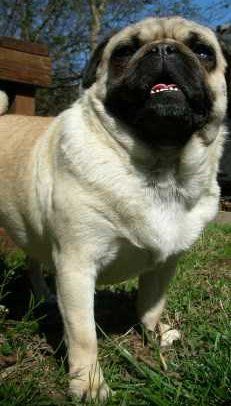
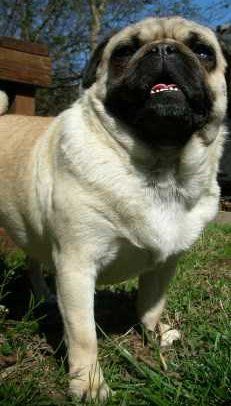
You may also like:
Differences between male and female Pugs
- Comparing the genders in regard to health, care and more.
Pug is eating poop
- Why a Pug may do this and exactly how to stop this from happening.
Harnesses for Pugs
- Why placing a harness on your Pug is a good idea, health issues it can prevent and what to look for when choosing a harness.
Teething toys for Pugs
- What to look for when choosing teething toys for your pup.
Long haired Pug dogs
- Interesting article, with photos, showing if this is a myth or if this type of Pug actually exists.
PetPugDog.com Copyright 2019. All rights reserved. Privacy Policy
We are a participant in the Amazon Services LLC Associates Program, an affiliate advertising program designed to provide a means for us to earn fees by linking to Amazon.com and affiliated sites.

